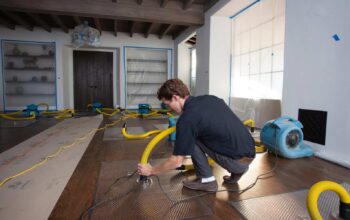A healthy human life depends on the availability of clean and safe drinking water. One way of ensuring that your water is free of any contaminants is by using an inline water filter. These filters are engineered to purify the water in your system, leaving you with clean and tasty water. If you’ve ever wondered how an inline fridge water filter works and how it operates, continue reading to find out more.
What is an Inline Water Filter?
In-line water filters are the filtration systems that are installed directly on your water line, usually underneath your sink or behind your refrigerator. In contrast with the water filters that are connected to the faucet or pitcher, the inline ones are invisible, and, as a result, the interior looks neat and clutter-free.
What Inline Water Filters Do and How They Work?
Inline water filters function in a similar way as a water filter, which uses media like activated carbon for trapping impurities such as sediment, chlorine, and lead. The filtered water then flows out of the filter system, ready to use.
The Advantages of Installing Inline Water Filters
Some of the key benefits linked with inline water filters for refrigerators are as follows:
- Improved Water Quality: With inline filters, you can filter out a large number of contaminants. This ensures that you will enjoy clean and safe drinking water always.
- Better-Tasting Water: Inline water filters for the home can remove impurities and hence improve the taste and odour of your water.
- Convenience: Inline filters are installed directly into your water line, so you don’t have to bother with pitcher filling or attaching a filter to your faucet.
- Cost-Effective: Inline filters are cheaper than purchasing bottled water or installing a whole-house filtration system.
Categories of Contaminants that Inline Water Filters Remove
A few of the many pollutants or contaminants this water filtration can remove are as follows:
- Sediment: Mud, sand, and rust particles.
- Chlorine: A common disinfectant found in municipal water supply.
- Lead: A toxic metal that can be present in the water from old plumbing systems.
Installation and Maintenance of Inline Water Filters
You will be at ease knowing that the installation process of inline refrigerator filter is pretty easy and straightforward. You jut need to follow the steps mentioned below to install.
- Turn off the water supply: Before installation, turn off the water supply to the area where you will be installing the filter.
- Cut the water line: Use a pipe cutter to cut the water line where you are planning to put the filter.
- Install the filter: Attach the filter to the water line by using the fittings provided with the filter.
- Turn on the water supply: After installing the filter, open the water supply and look for any leaks.
Inline water filter maintenance mainly involves replacing filter cartridges every 6 to 12 months according to the manufacturer’s guidelines. If you are someone not sure if you can install this water filter you can always take the help of the expert.
Diverse Applications of In-Line Water Filters
Some of the areas where online water filters are a must are as follows:
- Home Use: In-line filters can be fitted under your kitchen sink or behind your refrigerator to provide you with safe drinking water.
- RVs: Inline filters are also a great option for RVs to keep water clean and portable while camping.
- Marine Use: Inline filters can be installed on boats to ensure that a good quality water is available for drinking and cooking.
Cost Considerations
The average price of an inline refrigerator water filter is determined by the manufacturer’s brand and model. Nevertheless, they are way more economical than purchasing bottled water in the long-run. Moreover, the price of changing filter cartridges should be considered as well in your decision making to buy an inline water filter.
Environmental Footprint of Inline Water Filters
With the help of an in-line filter, one might be able to lessen the negative effects of bottled water on the environment. Using a filter, you can reduce the number of plastic bottles that end in up landfills, and in this way, you will help to protect the environment.
Common Questions and Concerns
Here are some common questions and concerns about inline water filters:
- Q. Do in-line water filters operate on fluoride?
A. Some of the inline filters that are specifically designed to get rid of fluoride, do not get rid of it all. Check the product specifications that the filter has fluoride removal as one of its functions. - Q. Can you use an in-line water filter with well water?
A. Yes, inline filters can be applied to well water, but you might require a filter that is designed to meet the special needs of well water. - Q. How often do I need to replace the cartridge?
A. Cartridge filters should be replaced every 6 to 12 months (depending on the manufacturer’s recommendations).
Water damage and water filters are two very different things, but they both relate to water in some capacity.
- Water Damage: This refers to any harm caused to a structure or property due to the presence or intrusion of water. It can occur from various sources such as floods, leaks, burst pipes, or even excessive humidity. Water damage can cause significant structural issues, mold growth, and damage to belongings if not addressed promptly and properly.
- Water Filters: Water filters, on the other hand, are devices designed to remove impurities, contaminants, and particles from water, making it safer and cleaner for consumption or use. Water filters can be installed at different points in a water supply system, such as under the sink, on faucets, in pitchers, or even integrated into whole-house systems. They come in various types, including activated carbon filters, reverse osmosis systems, UV filters, and more, each targeting specific contaminants.
So, in summary, water damage restoration refers to the harm caused by water intrusion, while water filters are devices used to purify water for consumption or other uses, aiming to prevent potential damage to health or property from contaminated water.
Final Words!
Inline water filters are very efficient and occupy a small space, so they are a perfect option if you want clean and safe drinking water. By realizing how inline filters work and the advantages they can bring, you can be assured of making an informed decision about whether an inline water filter is suitable for you.



